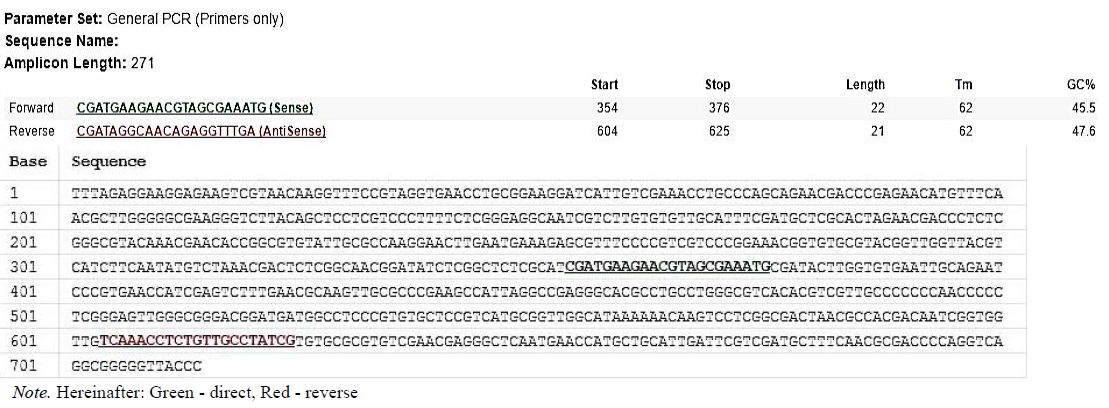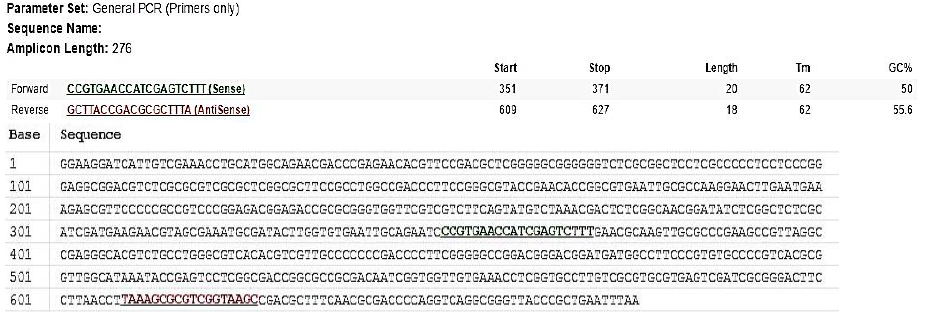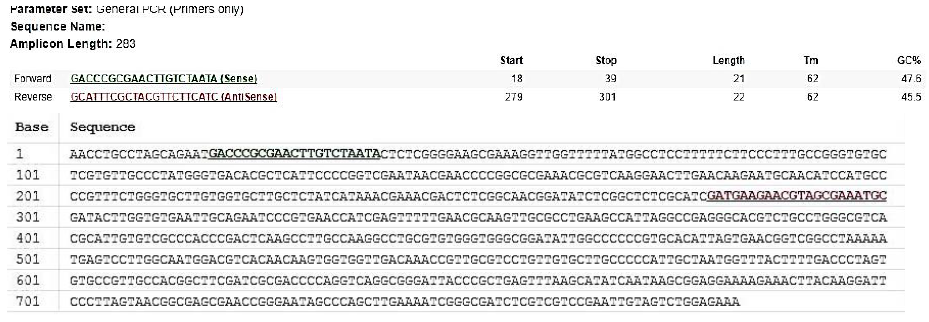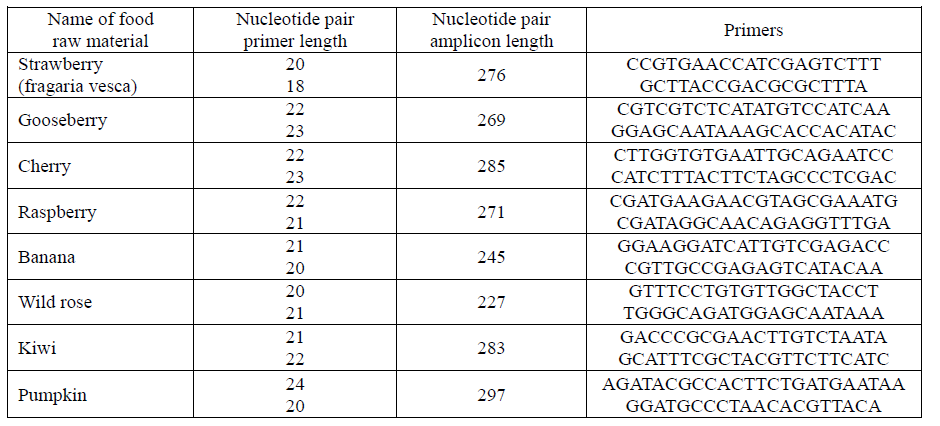Аннотация
Identification has similarities and differences with other kinds of assessment activity: quality assessment, control management and certification. The final result of identification is verification of compliance or detection of falsification. Common features are tests for definition of actual values. This paper studies the design of universal primers for type identification of fruit raw material (strawberry, gooseberry, cherry, raspberry, banana, wild rose, kiwi). To further verify the specificity of primers, sequencing of fragments is produced, which are read by each from the primer pairs. For this purpose, 8 polymerase chain reactions (PCR-reactions) are initiated, one from each primer pair corresponding to one type of raw material. A single alignment matrix for each of the studied objects is created as a result. Re-verification of each matrix is conducted for the presence of read errors or other disputed single- nucleotide substitutions. It is stated that the alignment matrices of the nucleotide sequences of raspberry, strawberry (fragaria viridis), gooseberry, wild rose, cherry, banana and kiwi are aligned on all sides and the protruding "bases" do not disturb the future work of programmes for the primers design. Universal non-intersecting primers are chosen to identify the fruit raw material under studying. As a result of the use of various software packages and of the database GenBank NCBI, we managed to find a suitable DNA zone for each of the tested samples of fruit raw material at the level of generic differentiation for further development on its basis of the universal primers. It is zone 18S rDNA. All the found sequences have both the conservative part for planting a pair of primers, and the variable one for reliable identification of species or for phylogenetic analysis. As part of the study, all samples of fruit raw material have been identifiedКлючевые слова
Fruit raw material, identification, PCR, matrix, primersВВЕДЕНИЕ
Identification as an activity has its own structure which includes objectives and tasks, objects and subjects, means and methods [1].
Identification has similarities and differences with other kinds of assessment activity: quality assessment, control management and certification. Common features are tests for definition of actual values and compliance test with the requirements of regulatory documents. The differences lie in the list of criteria; in the subjects which determine the assessment activity; in the final result. The final result of identification is verification of compliance or detection of falsification [2, 3].
The term "identification" is interpreted differently. The analysis of the regulatory documents showed that the term "identification" has the following definitions [13].
Identification is the procedure by which compliances of the products, submitted to certification, are established with the requirements for this type of products, set by the regulatory documents (Sertifikatsiya pischevykh produktov i prodovol'stvennogo syr'ya v RF [Certification of foodstuffs and food raw material in the Russian Federation], 1996).
As criteria of identification the indicators, meeting the following requirements, should be selected:
– typicalness for a particular type, name or homogeneous product group;
– objectiveness and comparability;
– ability to test;
– difficulty of falsification.
The greatest significance has the typicalness which can be characterized by complex or, less often, individual indicators that complement each other and have a varying degree of accuracy [4, 5].
The objective of this paper is the study of universal primers design for type identification of fruit raw material. The tasks of this paper include the selection of universal primers and the identification of such fruits and berries like cherry, strawberry, raspberry, gooseberry, wild rose, banana and kiwi.
ОБЪЕКТЫ И МЕТОДЫ ИССЛЕДОВАНИЯ
Alignments were visualized in the programme GeneDoc.
Matrices were aligned from the two sides of alignments. Presence of protruding "bases" may disturb the future programme work [15].
In accordance with the objective and the tasks of the present paper, the study objects were: Rubus idaeus (raspberry, the grade “Nagrada”), Fragaria vesca (remontant wild strawberry, the grade “Berdskaya rannyaya”), Ríbes úva-críspa (garden gooseberry, the grade “Kooperator”), Prunus fruticosa (ground cherry, the grade “Altayskaya lastochka”), Rosa majalis Herrm (cinnamon rose), Actinidia deliciosa (kiwi delicatessen), Músa paradisiaca (banana of "extra" grade).
Primers were selected with the use of the programme PrimerQuest (http://eu.idtdna.com/ Primerquest/Home/Index). Computer processing and sequences alignment were performed in the programmes ClustalW and GeneDoc, the construction of phylogenetic trees was performed in the programme Mega 6 [6, 7].
To further verify the specificity of primers, sequencing of fragments was produced, which are read by each from the primer pairs [14, 17]. For this purpose, 8 polymerase chain reactions (PCR-reactions) were initiated, one from each primer pair corresponding to one type of raw material [8, 9]. The obtained PCRproducts were re-precipitated by ethanol in the presence of ammonium acetate, dried and then sequenced according to Sanger using the device ABI Prism 3500xl. The sequencer output data - chromatograms - were converted into nucleotide sequence and then, using the BLAST algorithm, were compared to the NCBI sequences, present in GenBank [10, 11].
РЕЗУЛЬТАТЫ И ИХ ОБСУЖДЕНИЕ
At this research stage previously conducted alignments were visualized and corrected in the program GeneDoc [12]. Thus, a single alignment matrix for each of the studied objects was created (Fig. 1–7). Re-verification of each matrix was conducted for the presence of read errors or other disputed single-nucleotide substitutions.
Matrices were aligned from the two sides of alignments. Presence of protruding "bases" may disturb the future programme work.
The analysis of the figure shows that the alignment matrices of the nucleotide sequences of raspberry, strawberry (fragaria viridis), gooseberry, wild rose, cherry, banana and kiwi are aligned on all sides and the protruding "bases" do not disturb the future work ofprogrammes for the primers design.
Rectangular alignment matrices for each of the studied objects are presented in the figures.
Then, each matrix was loaded to the program PrimerQuest for sequences algorithmic analysis and search for optimal positions of the primers planting.
In the settings it was always stated that the maximum size of the amplicon, read by a pair of primers, should not exceed 300 b.p. An optimal pair of primers was selected from the ones, offered by the programme (Fig. 8). The following parameters were taken into consideration: primer length, annealing temperature, amplicon location.
Analyzing Fig. 8, optimal primers were selected.
Primers for the studied types of fruit raw material with the recommended parameters for PCR (visualization of the programme PrimerQuest) are indicated in Figures 9–15.
On the basis of Figures 9–15, universal nonintersecting primers were selected for determination by PCR method of fruit raw material (strawberry, gooseberry, cherry, raspberry, banana, kiwi). These primers are represented in Table 1.
Analyzing the tabular data, with the use of various software packages and of the database GenBank NCBI, we managed to find a suitable DNA zone for each of the tested samples of fruit raw material at the level of differentiation for further development on its basis of the universal primers. It is zone 18S rDNA. All the found sequences have both the conservative part for planting a pair of primers, and the variable one for reliable identification of species or for phylogenetic analysis.
Thus, as a result of study, a single alignment matrix for each of the studied objects of fruit raw material was created with the use of the programme GeneDoc, reverification of each matrix is conducted for the presence of read errors or other disputed singlenucleotide substitutions [12, 16].
Sequences algorithmic analysis and search for optimal positions of the primers planting are conducted with the use of the programme PrimerQuest with indication in the settings of maximum amplicon size, read by each primer pair, which does not exceed 300 b.p.
Optimal pairs for each type of fruit raw material are selected from the ones, offered by the programme, taking into consideration the following: primer length, annealing temperature, amplicon location.
СПИСОК ЛИТЕРАТУРЫ
- Avilova I.A. and Khlystov D.V. The possibility of using the method of IR spectroscopy for the analysis of raw materials and foods of plant origin. Izvestiya Jugo-Zapadnogo gosudarstvennogo universiteta. Seriya Fizika i khimiya [News of Southwest State University. Physics and Chemistry], 2014, no. 1, pp. 34-37. (In Russian).
- Urbanovich O.Yu., et al. Analiz genov ustojchivosti kak molekulyarnye markery dlya identifikatsii sortov rastenij [Analysis of stability of genes as molecular markers for identification of plant varieties]. Sbornik nauchnykh trudov «Molekulyarnaya i prikladnaya genetika» [Collection of scientific works “Molecular and applied genetics”], 2006, vol. 3, pp. 3-142.
- Golubtsova Yu.V. Selection of seeding molecules in the process of pcr-test-system creation for identification of vegetable raw materials in foodstuffs. The Bulletin of KrasGAU, 2014, no. 10, pp. 194-200. (In Russian).
- Guchetl S.Z., Cheljustnikova T.A., and Antonova T.S. The optimization of DNA extraction of broomrape (Orobanche cumana Wallr.) and the identification of polymorphic RAPD- and SSR-loci for genotyping of parasite. Refereed journal "”Oil crops. Scientific and Technical Bulletin VNIIMK”, 2013, iss. 155-156, pp. 17-23.
- Davidovich E.A. Identifikatsiya podlinnosti i urovnya kachestva kon'jachnoj produktsii [identification of originality and quality level of cognac products]. Pishhevaya i pererabatyvajushhaya promyshlennost'. Referativnyj zhurnal [Food and processing industry. Abstract journal], 2006, no. 4. p. 1012. (In Russian).
- Kolesnov A.Y., Filatova I.A., Zadorozhnaya D.G., Filippova R.L., and Volodina E.M. Practical aspects of identification juice and juice products: pomegranate juice and juice products. Beer and beverages, 2010, no. 4, pp. 41-45. (In Russian).
- Ostroumov L.A., Prosekova O.E., and Prosekov A.Yu. Osobennosti proizvodstva vzbitykh desertov na osnove belkovo-uglevodnogo i rastitel'nogo syr'ya [Specific features of production of whipped desserts based on proteincarbohydrate and plant raw material]. News institutes of higher Education. Food technology, 2003, no. 1, pp. 28-29. (In Russian).
- Prosekov A.Yu. Teoreticheskoe obosnovanie i tekhnologicheskie printsipy formirovaniya molochnykh penoobraznykh dispersnykh system [Theoretical justification and technological principles of formation of milk foam dispersed systems. Dr. tech. sci. dis. abst.]. Dr. eng. sci. thesis. Kemerovo, 2004. 42 p.
- Prosekov A.Yu., Mudrikova O.V., Bulavina A.V., and Arkhipov A.N. The methods of the DNA technologies for the vegetable raw materials identification in milk products. Dairy industry, 2011, no. 12, pp. 62-63. (In Russian).
- Prosekov A.Yu., Golubtsova Yu.V., and Shevyakova K.A. Influence of technological raw food treatment on the effectiveness of species identification. Food processing industry, 2014, no. 6, pp. 8-10. (In Russian).
- Rykov R.S. Razvitie metodov identifikatsii i kontrolya bezopasnosti napitkov [Development of methods of identification and control of drinks safety]. Cand. chem. sci. diss. Moscow, 2005. 137 p.
- Prosekov A.Yu. Theori and practice of prion protein analysis in food products. Foods and Raw materials, 2014, vol. 2, no. 2, pp. 106-120. DOI: 10.12737/5467.
- Dyshlyuk L., Babich O., Belova D., and Prosekov A. Comparative analysis of physical and chemical properties of biodegradable edible films of various compositions. Journal of Food Process Engineering, 2017, vol. 40, no. 1, Article number e12331. DOI: 10.1111/jfpe.12331.
- Novoselova M.V. and Prosekov A.Yu. Technological options for the production of Lactoferrin. Food and Raw Materials, 2016, vol. 4, no. 1, pp. 90-101. DOI: 10.21179/2308-4057-2016-1-90-101.
- Astakhova L., Babich O., Prosekov A., et al. Short chain fatty acids (SCFA) reprogram gene expression in human malignant epithelial and lymphoid cells. PLoS ONE, 2016, vol. 11, no. 7, pp. e0154102. DOI: 10.1371/journal.pone.0154102
- Prosekov A.Yu., Mudrikova O.V., Bulavina A.V., and Arhipov A.N. The methods of the DNA technologies for the vegetable raw materials identification in milk products. Dairy industry, 2011, no. 12, pp. 62-63. (In Russian).
- Bespomestnykh K.V., Babich O.O., Korotkaya E.V., and Prosekov A.Yu. Design of genus-specific and speciesspecific primers for indication and identification of Lactobacillus bulgaricus. Food Processing: Techniques and Technology, 2010, vol. 16, no. 1, pp. 64-68. (In Russian).

















